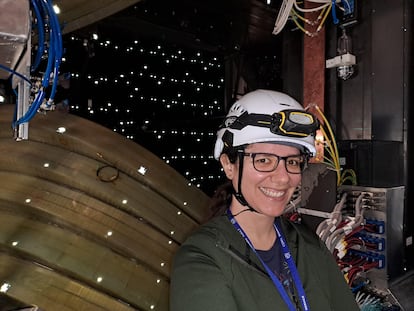The largest particle accelerator observes a fleeting imbalance between matter and antimatter.

The largest particle accelerator on Earth, the Large Hadron Collider ( LHC ) in Switzerland, has observed for the first time an asymmetry between matter and antimatter that is fundamental to the existence of the universe and could reveal phenomena beyond known physics.
The LHCb experiment has observed this imbalance in baryons, particles composed of three quarks, like neutrons and protons, that form the nuclei of atoms. Living beings, planets, stars, and galaxies are made of this type of matter, which accounts for 5% of the universe. This discovery is crucial for testing the correctness of current physical theories and may pave the way for understanding the remaining 95% of the cosmos.
The LHCb experiment studies the decay of elementary particles produced after the collision of protons traveling at almost the speed of light inside the LHC. Despite the unparalleled power of this accelerator, it took accumulating data since 2011—some 80,000 baryon decays—to observe for the first time a slight imbalance in favor of matter. The observed asymmetry averages 2.45%, but occasionally exceeds 5%. The results of this experiment, in which 1,600 scientists from 22 countries participate, are published today in Nature , a benchmark for the best science in the world.
Galician physicist María Vieites , 34, is the deputy physics coordinator at the LHCb. “Our universe is made of matter, and the Standard Model doesn't fully explain why,” she explains, referring to the current theory that describes particle physics. The problem is that this framework doesn't describe dark matter , which makes up approximately 27% of the universe, nor dark energy, which accounts for 68% .
“We need new sources of imbalance between matter and antimatter, and with this study we observe these differences in a new area, precisely in the type of conventional matter, more similar to that which makes up atomic nuclei,” highlights this researcher from the Galician Institute of High Energy Physics . “These results have taken a lot of work, because we are talking about very, very rare processes,” she adds. The LHCb collaborators have analyzed trillions of collisions between protons and isolated the decays of lambda b baryons, which are the promising particles for these measurements, explains Vieites. “For now, the data are probably compatible with the Standard Model,” the scientist acknowledges, “but ultimately we know that it is incomplete and must fail at some point.”

Particle physicists like to believe that nature respects symmetry, but if that were the case, the universe would not exist. The Big Bang theory holds that the universe emerged 13.7 billion years ago with an identical amount of matter and antimatter. These particles are symmetrical, like a real object and its mirror image, but oppositely charged, so they should have disintegrated each other in a massive burst of light. However, the cosmos today is made almost entirely of baryonic matter, the stuff of which atoms are made, and hardly any antimatter.
The first direct evidence of asymmetry was observed in 1964—at the height of the Cold War—at what was then the world's largest particle accelerator, Brookhaven National Laboratory in the United States. The facility had been built to investigate particle physics following the immense investment in the Manhattan Project , which culminated in the nuclear bombing of Hiroshima and Nagasaki. On that occasion, the discrepancy was detected in a type of particle known as a meson, composed of a quark and an antiquark.
Three years later, Russian physicist Andrei Sakharov , who developed the most powerful atomic bombs ever detonated on Earth for the Soviet Union—and later won the Nobel Peace Prize for warning of the terrible potential of such weapons—developed a key theory. He held that it was the asymmetry of baryons that was responsible for generating a universe full of matter. His proposal implied that, fractions of a second after the Big Bang, a phenomenon known as charge-parity symmetry violation occurred between matter and antimatter. For every billion antimatter particles, there would be one billion and one matter particles. From this tiny imbalance, the entire observable universe would have emerged, with matter dominating its opposite. Since Sakharov made this prediction almost 60 years ago, it has never been confirmed.
"This is the first time this phenomenon has been observed in these particles, and therefore, it's important," reasons theoretical physicist Juan Antonio Aguilar . "Theoretically, it's possible that what we've observed is new physics [phenomena beyond the Standard Model], but for now, it can't be proven because the calculations are too complex," adds the researcher from the Institute of Theoretical Physics (UAM-CSIC) in Madrid.
The discrepancy between matter and antimatter predicted by the Standard Model is much smaller than that observed in the universe. This implies that there must be more sources of asymmetry. One possible mechanism is the existence of unknown particles that increase the predominance of matter over antimatter. Among these particles could be dark matter. The motion of stars and galaxies in the universe has unequivocally demonstrated the existence of this substance through its gravitational pull. However, the particles that compose it have never been produced, possibly due to its weak interaction with conventional matter. Hunting down dark matter is the main objective of the LHC , which will soon begin a redesign phase to increase the number of proton collisions, which could finally lead to the discovery of unknown particles.
EL PAÍS




